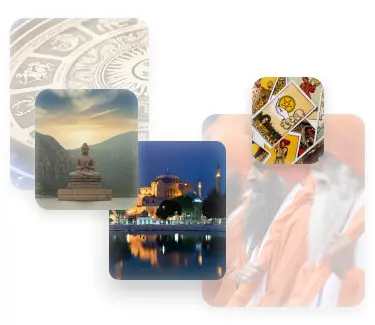According to most archaeologists, the heyday of the Maya lasted from the IV to the X century CE. The Maya achieved incredible success in the development of astronomy related to the practical needs of agriculture. In various Mayan inscriptions, special hieroglyphs have been found to designate planets, the Pole Star and a number of constellations. In one of the manuscripts, even a list of upcoming solar eclipses has been preserved. Astronomical observations were carried out in structures resembling the towers of modern observatories.
Mayan Astrology
The astrological system of the Maya Indians.
Mayan astrology was actively covered in the media in the late 2000s and up to 2012, because according to a number of conspiracy theorists and journalists, a global cataclysm was supposed to happen on December 21 (or 23), 2012, which could lead to the end of human civilization. The fact is that according to the Mayan calendar, the duration of one full cycle (as we mentioned earlier) is 5125 years, and 2012 was the last year of the cycle.
Despite the fact that the scientific community was skeptical of such a theory, it caused a serious resonance in the media sphere and in broad public circles.
A striking example was the call of the Mayor of the Brazilian city of San Francisco de Paula Decio Colla to prepare for the end of the world by accumulating essential goods and food.
In the USA at this time, sales of private underground bunkers increased sharply. There has also been at least one case of suicide related to the fear of death in the global cataclysm.
When creating the article, materials from the website www.yamaya.ru were used.
It originates in the territory of the “New World” — Central America, the lands now occupied by Guatemala, the southeastern part of Mexico and British Honduras. Especially interesting is the Yucatan Peninsula, which was once inhabited by Maya Indians who created their own distinctive culture. Now it is spread all over the world.
Unknown
A brief history
The ancient history of the Maya became known due to the fact that they had a custom to periodically put up steles in almost every settlement — stone pillars on which appropriate records of the most important events had been made and the date of the installation of the stele was indicated. It is possible that many of these monuments of the ancient Maya people have celebratory meaning or are associated with various historical events.
From these monuments it became known that during the first 8 centuries of Current Era, various Mayan tribes built more than a hundred cities.
Maya paid great attention to the issues of time-keeping and chronology. They were the creators of the original calendar systems, significantly different from all other calendars known to us.
Scientists from a number of countries have put in a lot of work to unravel the secrets of the Mayan script, their distinctive culture and, in particular, the calendar. It is necessary to note the fundamental contribution of the Soviet scientist Yuri Knorozov (1922-1999), who was the first to decipher the Mayan script. A lot has been done, although tremendous work will still be required to fully clarify all outstanding issues. However, many interesting things are already known. The literature on the Mayan calendar is very extensive.
The essence
It is known that the Maya used two calendar systems at the same time, differing in duration: the Long Count and the Short Count. The former was used in civil life, while the latter was associated with religious rituals.
365-day year ( “haab”). The Maya distilguished two kinds of long years. The 360-day year was called “tun” and was saved only for special purposes. In everyday life, a 365-day calendar year was used, which was called “haab” and which consisted of 18 months of 20 days. At the end of such a year, 5 more days were added, which were called “days without a name” and were considered unlucky. The priests knew that “haab” is a fraction of a day shorter than the true solar year and that about 15 extra days run up in 60 years.
Many researchers of Mayan culture believe that the Mayan calendar is more accurate than the Gregorian calendar. They explain this by the fact that, although the Maya did not have astronomical instruments, they learned to achieve high accuracy of their observations of the celestial bodies, using a special method consisting in observing the sky through long and narrow slits, a kind of “sights”.
260-day year (“tzolkin”). Quite differently, a short Mayan calendar year was built, called “tzolkin” and meant for ritual purposes. It consisted of only 260 days and was divided into 13 months, which, like “haab”, contained 20 days each.
Another feature of this calendar is the presence of a week consisting of… 13 days. The days of the week were indicated by numbers from 1 to 13. Therefore, “tzolkin” was a kind of combination of 20-day months and 13-day weeks. In it, the numbers of the week and the names of the days were repeated in a certain pattern. However, from some Mayan hieroglyphic texts, it can be concluded that the ancient Maya, in addition to the 13-day week, had another 9-day week, in which the account was kept not by day, but by night, and each night had one of the nine gods of the underworld as its patron.
There were two more larger cycles in the Mayan calendar: a 4-year cycle in which the names of days and the numbers of months were repeated, and a 52-year cycle (which was a combination of “haab” and “tzolkin”). The latter consisted of thirteen 4-year cycles and covered a period of 18,980 days. It repeated not only the days and numbers of the week, but also the numbers of the month. In fact, the period of 18,980 days contained 52 “haab” (365 × 52 =18,980) and at the same time 73 “tzolkin” (260 × 73 = 18 980). This dependence formed the basis of the harmony of the Mayan calendar.
Each New Year could only begin with one of the following four days: Ik’, Manik’, Eb’, and Kab’an. Every year they changed sequentially, and then this order was repeated.
The dating of any event in the Mayan calendar always consisted of the number of the 13-day week, the name of the day, the number of the month and the name of the month. For example, if the date is written like this: “6 Lamat 14 Shul”, then this means the 6th day of the 13-day week, Lamat day, the 14th day of the month of Shul. Such a date could be repeated only after 52 years, i.e. after 18,980 days.
Since in the Mayan civil calendar the year consisted of 365 days, and the month of 20 days, then every four years the first day of the year fell on the same day of the month, but on different days of the week. Therefore, the entire 52-year cycle of the ancient Mayan calendar can be represented in the form of an “eternal calendar”, called the “calendar circle”.
Lunar calendar. The ancient Maya also used a special lunar calendar, each month of which contained 29 or 30 days. Each day of the lunar month was designated by a corresponding number, and the first day of the month, as in the 20-day month, was considered zero. After six lunar months, the lunar half-year ended, after which the first lunar month began again. At different times in the ancient Mayan cities, as in our time in some countries of the East, various versions of lunar calendars were used. It all depended on which lunar date was considered to correspond to the initial cyclic date of the Maya era.
Kin of Fate and the Oracle of Kin
In the Mayan Calendar, a Nickname means a measure of calculation – one year, one month, one day.
Kin has properties – tone and print.
Each person has his own Personal Galactic Seal, which determines the traits of a person born on this day. This energy is called the Kin of Fate and stays with a person for life.
In addition, on each birthday, a person acquires new energy for the year ahead. The acquisition of new energy helps a person to experience all possible types of energies.
Not only a person has his own tone and seal, but also every year and every day, as well as the tone of the month. That is, it turns out that the cycle is in a cycle and we live several energies at once at the same time.
The Personal Galactic Seal tells in symbolic language about who we are, as an energy potential. It shows exactly what we should do in life and what qualities of this energy we need to master and embody.
One of the 13 Galactic Tones of Creation gives each of us a special creative power. He suggests: what is our creative natural potential that we can use to more effectively solve our life goals in the current time cycle.
One of the 20 Seals describes the stages of the development of our consciousness: from birth — the first seal (Dragon) to enlightenment — the twentieth seal.
You can calculate the horoscope of the Mayan calendar here: https://yamaya.ru/
Biography of creators
Unknown.
Modern Leaders
Jose Arguelles (01/24/1939 – 03/23/2011) – Spiritual Name Valum Votan – artist, poet, mathematician, researcher of cosmic harmony; Doctor of Sciences, inspirer and permanent contributor for the World Movement for the Calendar of 13 Moons and President of the Foundation for the Law of Time. He is the author of numerous works, such as “Time and the Technosphere”, “The Probe from Arcturus”, “Zuvuya Sliding on the Waves”, “The Maya Factor”, “The Ascending Earth”, “The Call of Pakal Votan”, etc. Referred to as a New Age priest, he is one of the founders of Earth Day concept, and Harmonic Convergence in 1987.
Scandals
To be updated
Rituals
Nowadays, in temples covered with hay, sacrifices are still carried out (fortunately, not human). During the rites, participants play musical instruments (pipes, drums), dance.
Holy places
Currently, there are about 430 historical locations associated with the Mayan culture, among the largest, with particularly outstanding architecture or sculpture, are: Chichen Itza, Palenque, Uxmal and Yakchilan in Mexico, Tikal and El Mirador in Guatemala and Copan in Honduras.



 RU
RU
